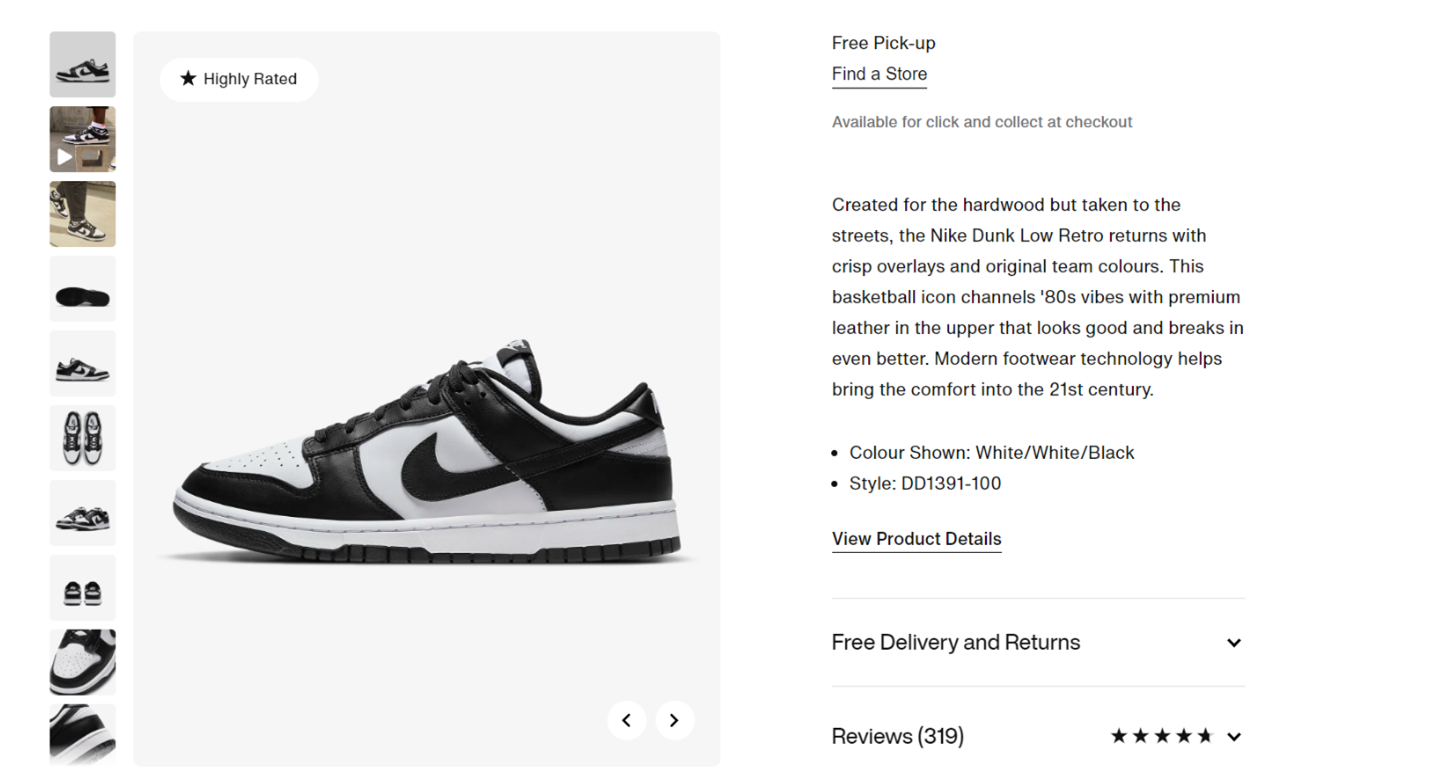Ecommerce SEO tips for improving your product pages and where you may be going wrong
In the rapidly evolving landscape of the digital age, the behaviour of consumers online is constantly shifting. A recent 2023 study discovered that factors such as brand trustworthiness and price competitiveness are key drivers in influencing consumers’ online shopping decisions. Product pages play a key role in a customer’s journey, so it is vital to perfect your eCommerce product content.
When you write product descriptions, there are two key things you need to bear in mind. Firstly, you need to add high-quality, original content for search engines to give you a higher chance of users visiting your product page. Secondly, your product page content needs to effectively hook your readers and act as an online sales pitch for your product.
Businesses often make mistakes in their product content that can negatively impact the visibility of their pages and how consumers respond to the content. Read the top 4 common mistakes made when writing product content, and our top 4 expert tips on making an impact with your product content.
Are your product pages failing to perform? Here are 4 ways you may be going wrong:
1) You are including duplicate content in your product descriptions.
Using duplicate product descriptions can have negative consequences for your online marketing efforts, as search engines penalise websites for using duplicate content. Many eCommerce businesses rely on manufacturer-provided product descriptions to save time and effort in creating their own. Your supplier or manufacturer may provide you with some product descriptions; however, these assets may be uninteresting and lack key information. It is vital to create fresh, original, and engaging eCommerce product pages.
Duplicate product descriptions can ultimately lead to decreased website traffic, and if you use manufacturers’ product descriptions without making any changes, your content may be seen as less trustworthy and of low quality by search engines.
Read about the top recent algorithm changes that may impact your eCommerce content here.
2) You are listing features, rather than focusing on the benefits of your products.
Product descriptions should not simply be a list of the features of products. Instead of listing only features, focus strongly on your product’s benefits. What problems does the product solve? How will it improve the lives of your customers? Putting yourself in your customers’ shoes can be a great way of ensuring you are answering the questions they may have and that you are using a tone of voice that will resonate with them. A lack of emotive language can leave a product description feeling robotic and ineffective, making it less likely to leave an impact on the reader as it will not spawn an emotional response.
Ensure your product content answers the main questions you will be expected to answer:
- What is the purpose of the product?
- What are the product’s key selling points?
- What are the main benefits of the product?
- What sets this product apart from others on the market?
- Is there any additional information that would be helpful to know?
3) You are not including key information, such as pricing, reviews, and shipping.
If you don’t supply the right content for search engines and users, there is little chance of your content appearing in google search results. It is more important than ever to be transparent in your product descriptions, and Google rewards detailed content that answers all the readers’ questions. Every bit of product data counts and can help to improve the depth of your content.
Consumer trustworthiness is a key driving factor when it comes to achieving conversions. The rising importance of social proof and user-generated content in product pages also demonstrates why it is vital to include features such as snippets of product reviews, testimonials, and case studies in your product pages. Online reviews have been proven to help provide consumers with confidence, convincing them to make a purchase. Online reviews created by previous consumers who have purchased the products are evolving from simple text snippets to photo and video formats. Image-based reviews have been proven to improve consumers’ understanding of the benefits of a product and can have a significant influence on customers’ product valuation.
Do you want to stay ahead of the curve? Subscribe to our Newsletter and receive our Exclusive Whitepaper upon publication.
4) You are neglecting internal linking.
Clear site architecture is crucial for SEO success. A well-structured website, with a logical hierarchy from the homepage to product categories and individual products, enhances both Google’s understanding of your site and your product visibility. While high-quality product descriptions are important, clear navigation paths are also essential. Clear navigation not only aids Google in efficiently crawling and indexing your site but also distributes link authority effectively when you internally link to other pages. Neglecting internal linking can isolate pages, affecting their ability to gain traction. When a parent category page is removed, this can result in “orphan” pages that do not have an internal link from anywhere else on your site. In most cases, a lack of internal links and orphan pages can result in lower rankings.
Internal linking and a clear site architecture is not just important for search engines – it is also vital for user experience. Your website’s internal links lead users to relevant content and distribute authority across the website. Ask yourself whether your product pages are easy to find for users, and ensure you are utilising internal links to product pages across your eCommerce content. To improve visibility of related products and ranges, it can be a good idea to include a product carousel on your product page that links to suggested products. Including internal links can encourage the customer to stay on your ecommerce store and explore related products and content. According to a report by Linnworks, 76% of consumers say website convenience is a top priority when choosing a retailer, while nine out of ten customers admit they would select an online store that provides a seamless shopping experience.
Learn more about our eCommerce services here to find out how we can help you supercharge your eCommerce SEO strategy.
4 Do’s for improving your product descriptions
1) Consider the customer’s perspective as well as SEO best practices.
To solidify recurring customers, you should care about optimising your pages with SEO best practices. This means conducting keyword research and optimising your product pages so they can rank for relevant keywords people search on Google and other search engines. Optimising pages on your site for relevant product keywords will help you to rank higher and increases the likelihood of customers coming across your products.
However, to reach out to your audience and encourage them to purchase your product – it is vital that your description creates a vivid picture of your product in your potential customer’s mind. Use sensory words that evoke emotions and paint a picture of the product in action. Ensure your description’s tone of voice is consistent with the other content on your eCommerce website and is tailored towards your typical customer. Your language should reflect what you’re trying to make the reader feel. This may mean replacing some words with more appropriate alternatives to bring across the intended emotion.
For example – the following product description from Nike features the tone of voice and terminology that their customers would be drawn to. For example, the shoe is referred to as a “basketball icon”, “created for the hardwood but taken to the streets”. Associating the trainers with basketball and using terms such as “90’s vibes” helps readers to picture themselves in the shoes and the style and impression they will portray when wearing them.

This language sells the lifestyle and experience the reader can expect once they purchase the shoes, rather than simply the practical features of the product. They can then picture themselves wearing the product more easily, which creates more of a connection and makes the customer more likely to purchase the product.
Find out how we have helped clients increase their conversions and improve their online visibility in our client case studies.
1) Showcase your difference.
Highlighting unique selling points (USPs) can help differentiate your product from competitors, making it more appealing to customers. Make sure to focus on the benefits of your product and how it solves a problem for your customer. If your product’s USPs do not jump out to readers – chances are your product descriptions aren’t doing anything at all.
When writing your product content, consider: what is it that makes your brand stand out? Do you offer longer product guarantees than competitors, offer competitive prices, or the most durable material on the market, for example? These are the features you need to ensure jump out to your readers in your meta information, header, and product introduction.
Learn more about our eCommerce services here to find out how we can help you supercharge your eCommerce SEO strategy.

1) Include FAQs to increase depth and achieve your SEO goals.
High-quality content is necessary for your product page to rank in SERPs, and it is therefore vital to create a detailed product page that ticks all the boxes for readers. As such, your product page would benefit from a section of frequently asked questions to help you achieve your search engine optimisation goals. This will help answer customers’ questions after visiting your product page.
It is hugely important to foresee and answer all readers’ possible concerns to persuade them to convert. If you don’t include frequently asked questions, your readers may miss a key aspect of a product that may be the difference between them making a purchase or leaving the page.
2) Conduct competitor research.
Having a look at what your competitors are doing can give you an idea of what your eCommerce product pages may be missing, and what your competition is doing better. Are you missing out on a trick such as including product reviews, videos, or interactive features? You may also be missing relevant keywords that your competitors may be utilising. Tools such as SEM Rush’s Keyword Gap tool can also help you to identify relevant keywords that your competitors are ranking higher for.
Knowing what your competitors are doing also allows you to innovate beyond what they offer. This could mean providing a more engaging, interactive online experience, or answering questions your competitors don’t address.
Running an eCommerce business is time-consuming, and it can be difficult to juggle multiple things at once. Book a consultation with us today to find out how SPACE can help.
Why choose SPACE?
Our service specialises in helping eCommerce brands navigate the complex, shifting digital marketing ecosystem improving Site Traffic, Conversion Rates & Average Order Value. With eCommerce brands, there is no “one size fits all”, and our tailored solutions ensure your website stays visible and competitive. We ensure products are seen when it matters most, and we use advanced services to target shoppers at each stage of the conversion funnel. Our team will assist you in identifying the cause of stagnant growth and will help you break out of your profit prison.
Learn more about our eCommerce services here to find out how you can succeed in the ever-changing digital landscape.
Find out how we have helped clients increase their conversions and improve their online visibility in our client case studies.
Related content
Why is good user experience important when it comes to SEO content for your website?
Five ways you can use AI to enhance your eCommerce content, and five things to avoid
Where are you going wrong with your paid ads? Here are our top 5 tips
